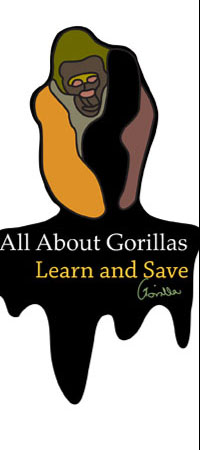|
Recent research has shown that the parasite Plasmodium falciparum that aggressively infects millions of humans each year has been found in gorillas, along with two new species of malaria parasites (Plasmodium GorA and Plasmodium GorB). Plasmodium falciparum originated from a closely related parasite found in chimpanzees in equatorial Africa and is responsible for 85 percent of malaria infections in humans and nearly all deaths from the disease. Increase in logging, deforestation, and bushmeat hunting favors the transmission of new parasites to humans from gorillas and vice versa.
Ebola virus is extremely lethal for humans and other great apes including gorillas. Between 2001 and 2005, at least 5,500 were killed at the Lossi Sanctuary in northwest Republic of Congo. Recorded outbreaks of the Ebola virus since 2000 might have claimed thousands of gorillas in Africa. It is unclear how the disease is spread but likely through the butchering and handling of primate bushmeat. Mountain gorillas have not yet been affected. The conservation implications of Ebola virus are significant since past outbreaks have occurred mainly in remote protected areas that were the stronghold for gorilla protection.
Threats
Bushmeat trade
In some parts of Africa gorillas are hunted for their meat. Animals are caught using snares or riffles and taken to markets usually far away. Sometimes gorillas are unintentionally caught in snares designed to trap other animals. Though such trade is illegal, people go to great lengths to avoid detection and trade can be difficult to monitor. In particular western species of gorilla have been most affected by the bushmeat trade. A recent undercover investigation conducted by Endangered Species International has found that up to two gorillas are killed and sold as bushmeat each week a region of the Republic of Congo.
Habitat Loss
Destruction of forest areas due to commercial logging and agriculture is having a huge effect on gorilla populations. Approximately 80% of gorillas live in unprotected areas and are therefore exposed to human influence on their environment. The opening up of new areas for industries has brought a new labour force into remote areas, where bushmeat is hunted for sustenance. Improved infrastructure such as the building of roads has also given illegal trappers easier access to gorillas and caused habitat destruction. Accidental or uncontrolled bushfires can also spread through habitats stripping areas of vegetation that gorillas could feed on. Due to their shy natures and wariness of humans gorillas are pushed into smaller areas away from human activity.
Conflict/ Civil war
In the past war has forced refugees into areas of gorilla habitat and with limited access to food people are pressured to hunt for bushmeat. Human presence in areas of gorilla habitat also increases the risk of human to gorilla disease transmission. With political instability and limited funding monitoring and protecting gorilla populations becomes difficult.
Disease
Gorillas are susceptible to the same diseases as humans and are particularly vulnerable to respiratory infections. Any form of contact with humans or human debris can transmit diseases to gorillas (see also Diseases section above). As a preventative measure tourists have to abide by strict regulations when viewing gorillas keeping a safe distance away. The Ebola virus is another huge problem facing gorillas as it spreads quickly and in 80% of cases leads to death. Scientist Peter Walsh stated ‘A quarter of the gorillas in the world have died form Ebola in the last 12 years’ and found in one study area that 5000 gorillas had died from the disease.
Pets/Souvenirs
Some gorillas are hunted for their body parts for medicinal use and hands, skulls and feet are sold illegally as souvenirs. In some cases infants are stolen to be sold as pets, in these situations adults are usually killed as they will fight to the death to protect their young.
|









